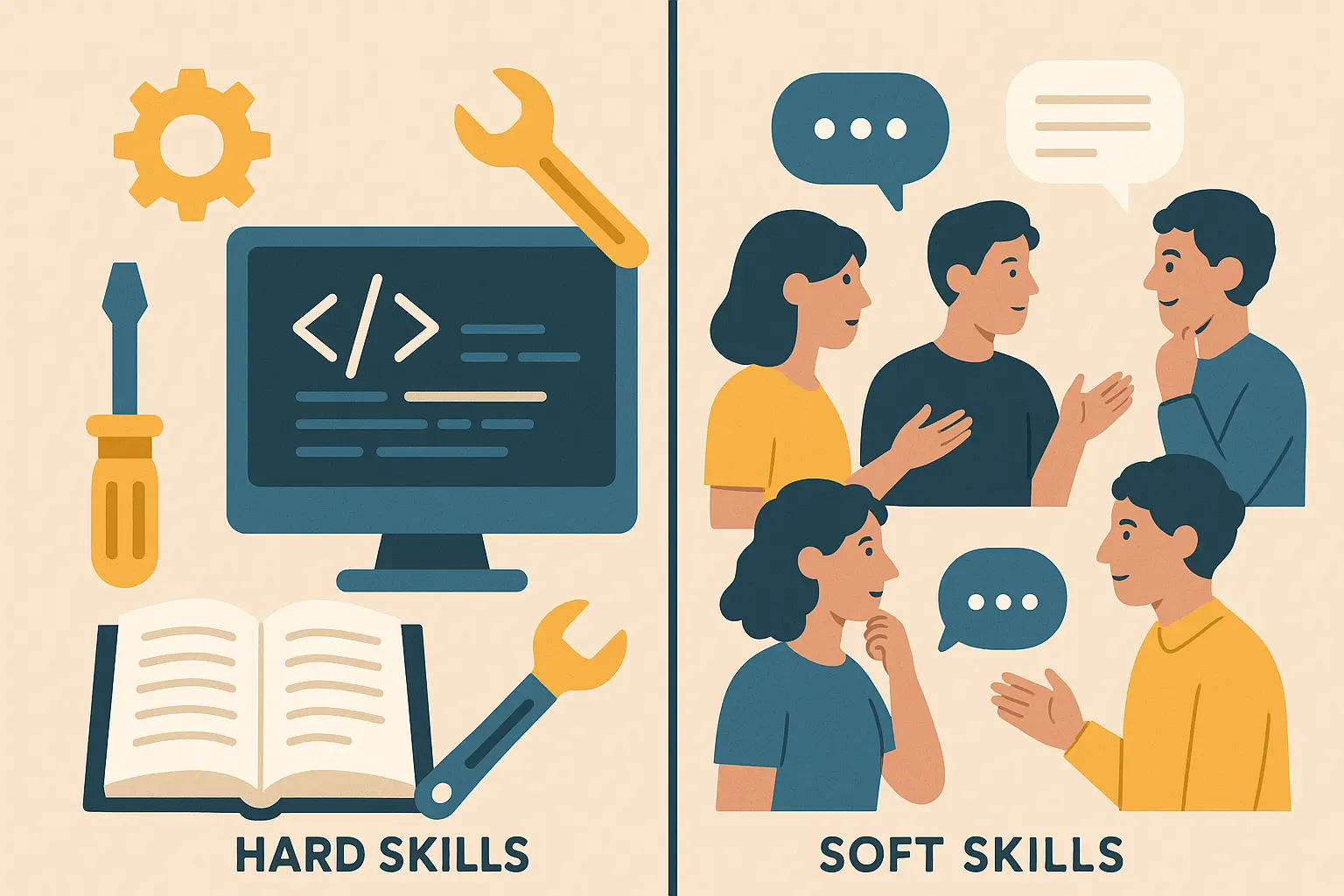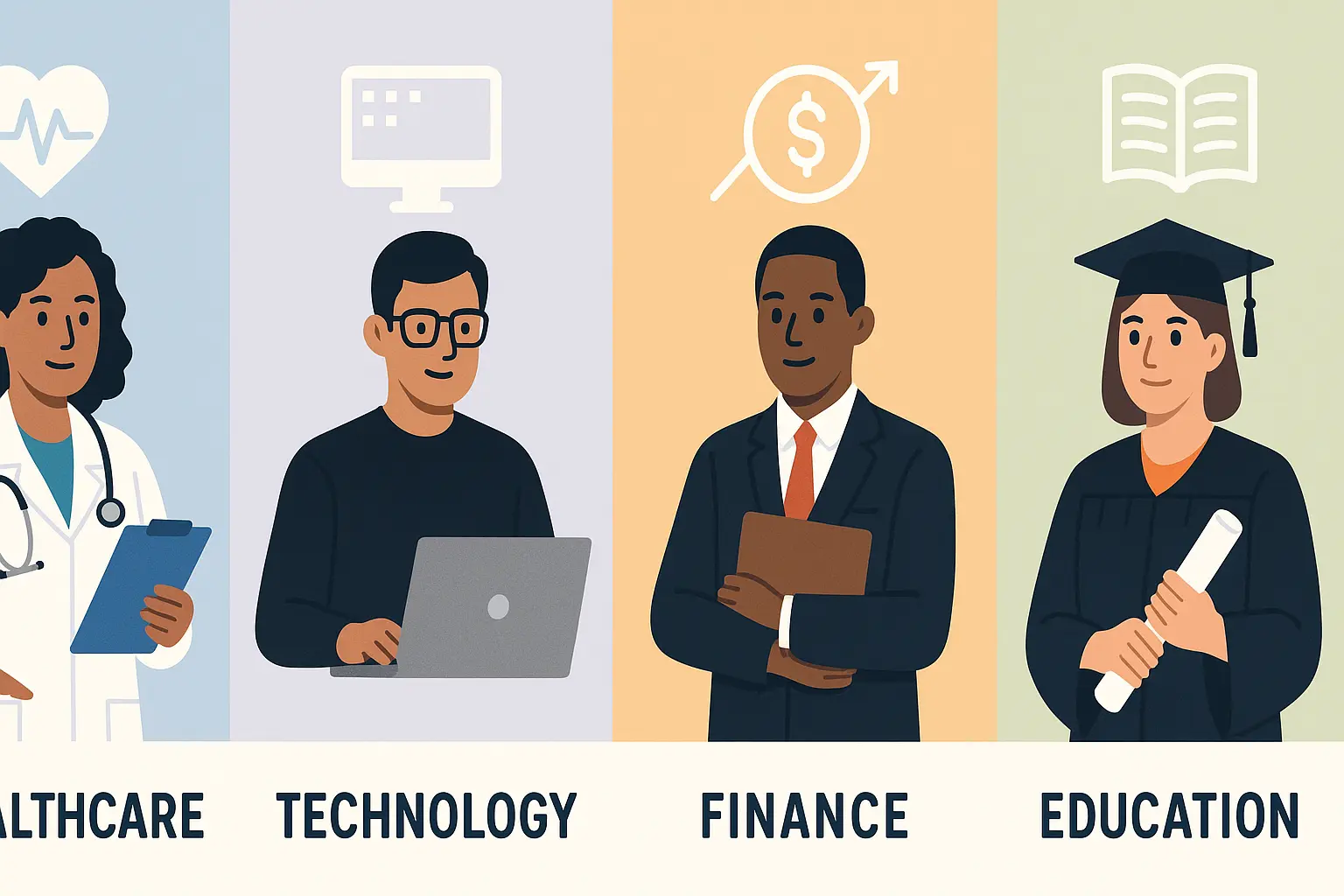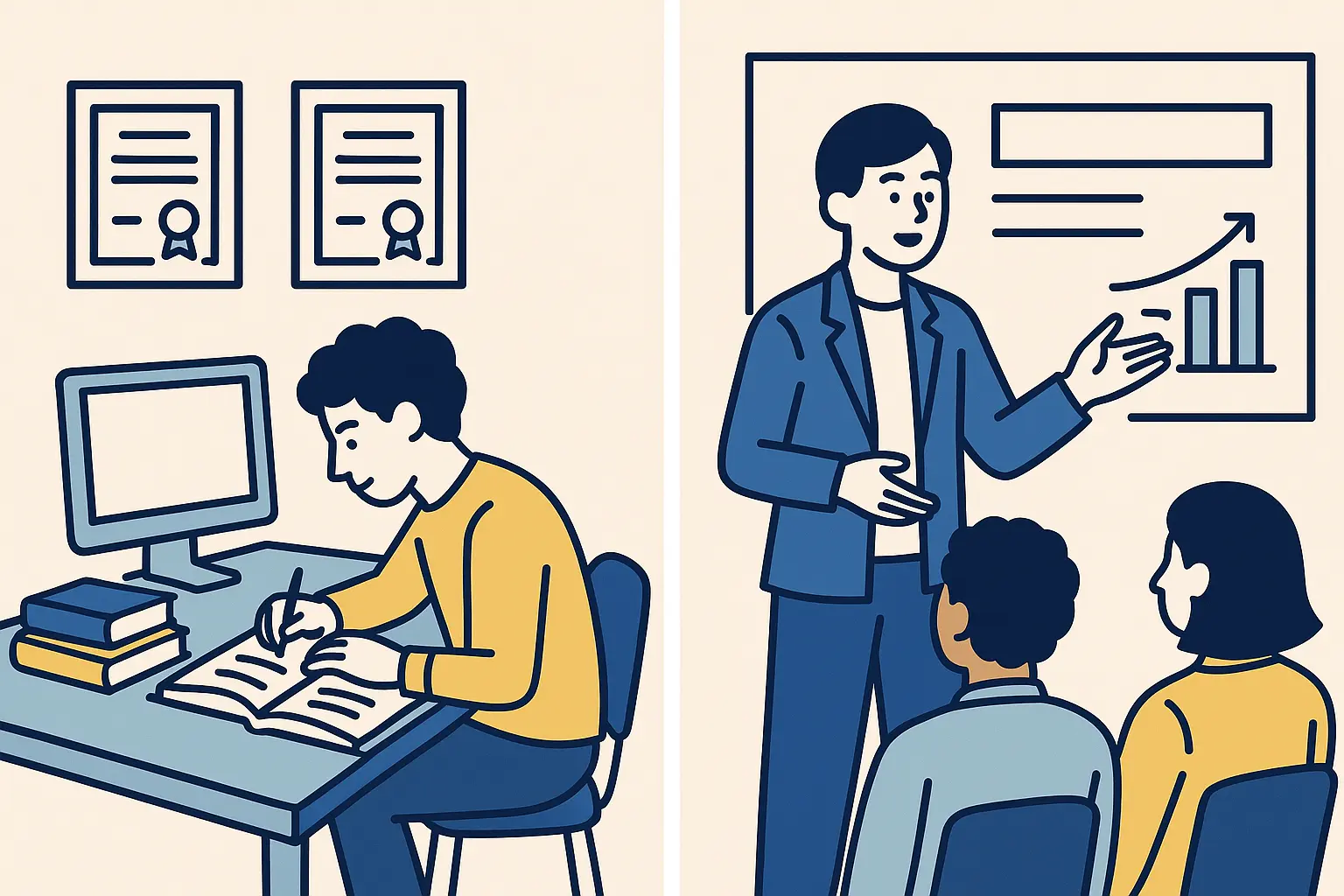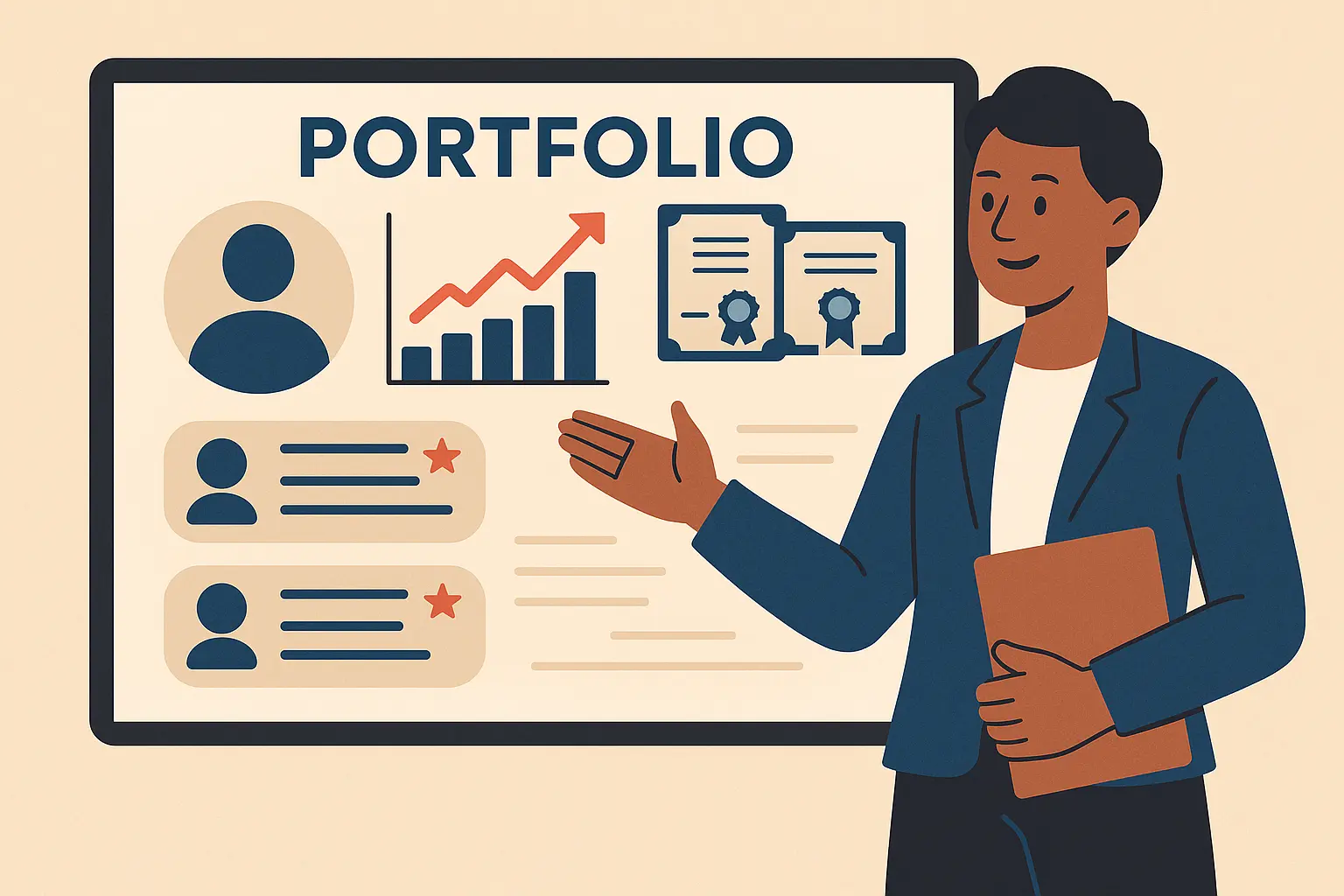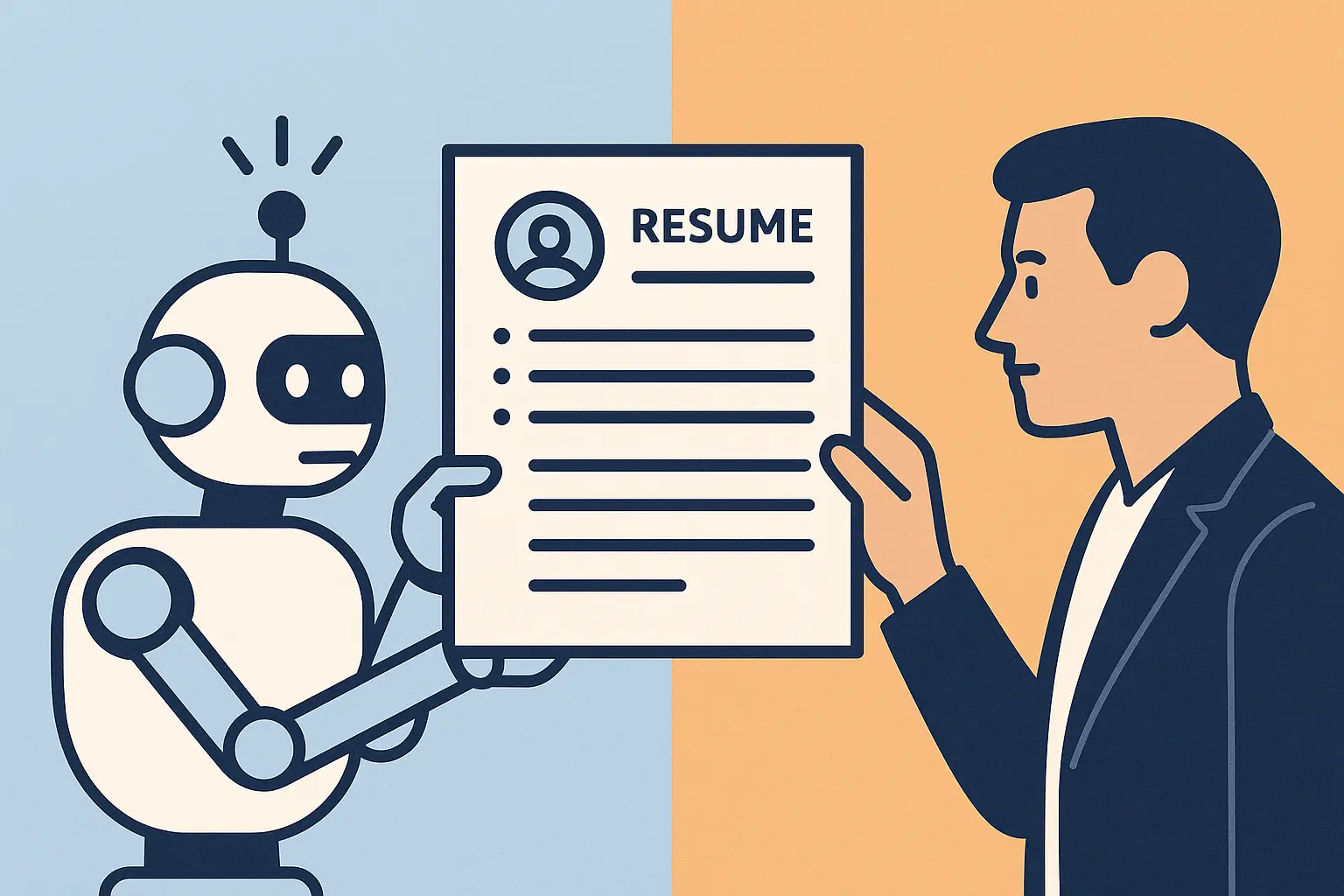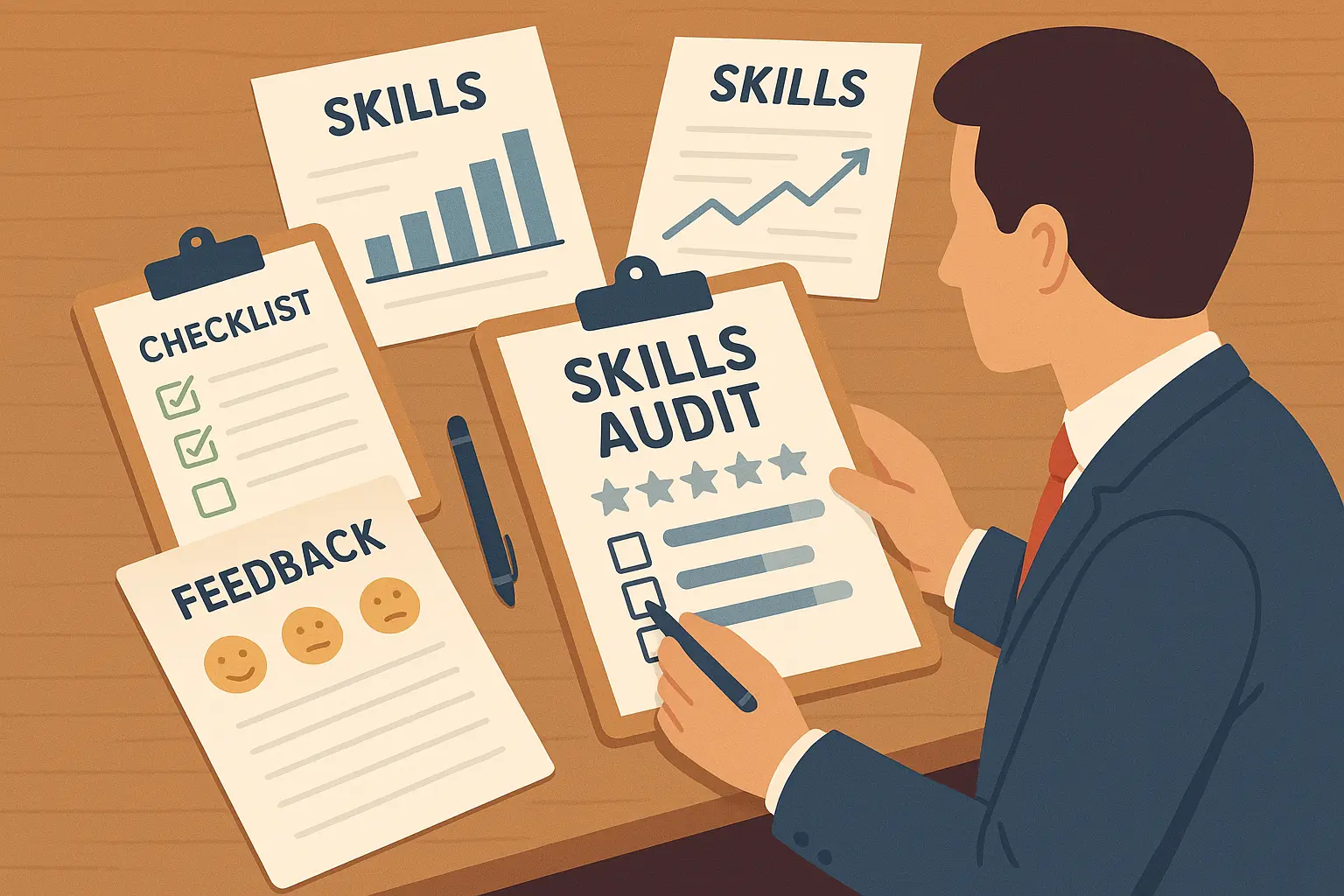Hard Skills vs Soft Skills: Why Most People Get This Balance Completely Wrong (And How to Fix It)

TL;DR
- Technical skills get you in the door, but people skills get you promoted
- This is the essence of the hard skills vs soft skills debate that shapes most careers today.
- Different industries need different balances—there’s no one-size-fits-all approach
- You can’t fake either type of skill, but you can learn both with the right strategy
The Skills Mistake That’s Killing Careers
Here’s what I’ve learned after watching talented people struggle for years: the whole hard skills vs soft skills debate is missing the point.
I’ve seen brilliant coders who couldn’t explain their work to save their lives, sitting in the same junior role for five years. I’ve watched charismatic people-persons get passed over because they couldn’t back up their ideas with real expertise. Both groups made the same mistake—they thought they had to pick a side.
The truth? Employers don’t want you to choose anymore. They want someone who can build the system AND explain why it matters to the budget committee. Someone who understands the data AND can tell a compelling story with it.
It’s not about being perfect at everything. It’s about knowing when to lean on your technical expertise and when to rely on your ability to work with people.
The numbers back this up too. 93% of employers state that soft skills are either an essential or very important factor in hiring decisions, but that doesn’t mean technical skills don’t matter. It means both matter more than ever.
Many professionals struggle with presenting their competencies effectively, which is why understanding how to showcase hard skills on your resume becomes crucial for standing out in competitive job markets.
What Actually Separates Hard Skills from Soft Skills
Let me clear up the confusion around hard skills vs soft skills once and for all. Hard skills are the stuff you can test. Can you code in Python? Can you run a financial analysis? Do you speak Spanish? These are measurable, provable abilities that either you have or you don’t.
Soft skills are how you apply those abilities when other people are involved. How well do you explain complex ideas? Can you lead a team through a crisis? Do you adapt when everything goes sideways?
Here’s where it gets interesting: neither type works alone anymore.
Technical Skills: The Foundation You Can’t Skip
Your hard skills are your credibility. They’re what get you in the room and give you the right to have an opinion. Without them, your soft skills don’t matter because nobody will listen to you.
But here’s what most people get wrong: they think listing every software program they’ve ever touched makes them impressive. It doesn’t. What matters is depth in the skills that actually move the needle in your industry.
The hard skills that actually matter:
- Programming languages you can solve real problems with (not just ones you’ve dabbled in)
- Industry-specific tools you use regularly
- Certifications that employers recognize and value
- Technical knowledge that gives you credibility in your field
- Analytical abilities you can demonstrate with concrete examples
| Hard Skills Category | Examples | How Employers Test Them |
|---|---|---|
| Programming Languages | Python, Java, JavaScript, SQL | Coding challenges, portfolio review |
| Software Proficiency | Adobe Creative Suite, Salesforce, Excel | Practical demonstrations |
| Certifications | PMP, AWS, Google Analytics | Official credentials |
| Technical Analysis | Data modeling, statistical analysis | Project walkthroughs |
| Industry Knowledge | Regulatory compliance, safety protocols | Scenario-based questions |
People Skills: The Multiplier That Changes Everything
Soft skills are harder to pin down, but they’re what turn your technical abilities into career advancement. They’re how you get your ideas implemented, your projects approved, and your teams motivated.
The mistake most people make is thinking soft skills are just about being nice. They’re not. They’re about being effective with people.
My friend Sarah was a perfect example. She could build complex financial models that would make your head spin, but she couldn’t get anyone to use them. Her analysis was brilliant, but her presentations put people to sleep. She had the hard skills but lacked the soft skills to make them matter.
After working with a mentor on her communication style, Sarah started framing her analysis in terms of business impact rather than technical details. She learned to tell stories with data instead of just presenting numbers. Within 18 months, she was promoted to Senior Analytics Manager, leading a team of five analysts.
The technical skills gave her credibility. The soft skills gave her influence.
Problem-solving was the most in-demand soft skill, with 21% of respondents actively working on improving this skill, followed by effective communication at 14%. This shows which people skills are actually moving careers forward right now.
Where Technical Meets Human (And Magic Happens)
The most successful people I know don’t just win the hard skills vs soft skills balance—they understand how to blend them seamlessly. They use their technical expertise to build credibility, then leverage their people skills to scale that expertise through others.
Think about it: the data scientist who can translate insights into business strategy. The engineer who can explain technical constraints to non-technical stakeholders. The project manager who understands enough about the technology to ask the right questions.
These hybrid abilities don’t fit neatly into “hard” or “soft” categories, but they’re increasingly what separates good performers from great ones.
Why Your Industry Changes Everything
Here’s something nobody talks about: the balance between technical and people skills varies wildly depending on where you work. What works in a Silicon Valley startup will bomb in a traditional manufacturing company. The communication style that succeeds in healthcare might fall flat in finance.
I learned this the hard way when I helped a brilliant software architect transition from a tech company to a financial services firm. His technical skills were solid, but his direct, informal communication style—which worked great with developers—didn’t land well with risk-averse banking executives. We had to recalibrate his approach without changing who he was.
Technical Skills by Industry: What Actually Matters
Every industry has its own set of “must-have” technical skills that serve as entry tickets. But here’s what’s interesting: how those skills are valued and applied varies dramatically.
In tech, your coding abilities might be everything. In consulting, your analytical skills matter more than your specific software knowledge. In healthcare, your clinical expertise is non-negotiable, but your ability to use healthcare technology is becoming equally important.
The top five hard skills in demand in 2023 were software development, SQL, finance, Python, and Java Money Talks News. But notice something? These are all technical skills that require strong communication to be truly effective.
Industry-specific technical priorities:
- Technology: Programming languages, cloud platforms, cybersecurity knowledge
- Finance: Financial modeling, risk analysis, regulatory compliance
- Healthcare: Clinical procedures, medical technology, patient management systems
- Marketing: Analytics platforms, content management, SEO tools
- Manufacturing: Quality control systems, supply chain software, safety protocols
People Skills: The Universal Language
While technical requirements vary by industry, certain people skills translate everywhere. But—and this is crucial—how you express these skills needs to adapt to your environment.
The leadership style that works in a creative agency (collaborative, flexible, inspiring) might not work in a law firm (structured, precise, authoritative). The communication approach that succeeds in sales (persuasive, relationship-focused) might fall flat in engineering (data-driven, logical, direct).
Soft skills were the most sought-after qualities for 91% of management positions, 86% of business operations roles, and 81% of engineering jobs. Even in highly technical fields, people skills are becoming essential.
Universal people skills (with industry adaptations):
- Communication: Varies from technical documentation to client presentations
- Leadership: Ranges from team motivation to strategic vision
- Problem-solving: Adapts from creative brainstorming to analytical troubleshooting
- Adaptability: Shifts from handling change to driving innovation
- Collaboration: Spans from teamwork to stakeholder management
Building Skills That Actually Get You Hired
Here’s where most career advice goes wrong: it treats all skill development the same way. It doesn’t. Learning technical skills follows a completely different path than developing people skills.
Technical skills are more straightforward. You can learn Python through online courses, get certified in project management, or master Excel through practice. The path is clear, the progress is measurable, and the validation is objective.
People skills are messier. You can’t learn leadership from a textbook or master communication through YouTube videos alone. These skills develop through real interactions, feedback from others, and lots of trial and error.
Mastering Technical Skills: The Structured Approach
Technical skill development is like following a recipe. There are proven methods, clear milestones, and objective ways to measure success.
The key is being strategic about which technical skills to develop. Don’t just learn what’s popular—learn what’s valuable in your specific career path.
Getting Certified (And Why It Matters)
Certifications aren’t just pieces of paper—they’re credibility signals that help you stand out in crowded job markets. They show employers you’re serious enough about a skill to invest time and money in formal validation.
But here’s the catch: not all certifications are created equal. Research which ones actually matter in your industry and focus on those.
Steps for strategic technical development:
- Research which certifications employers in your field actually value
- Choose learning paths that align with your career goals, not just current trends
- Build a portfolio of projects that demonstrate your abilities in action
- Stay current with industry changes—yesterday’s hot skill might be tomorrow’s commodity
- Focus on depth over breadth—it’s better to be excellent at a few things than mediocre at many
Self-Directed Learning: Making It Stick
Online courses and tutorials give you flexibility, but they require discipline. The biggest challenge isn’t finding good content—it’s sticking with it and ensuring you’re learning relevant, current information.
The secret is combining learning with doing. Don’t just watch tutorials; build things. Don’t just read about concepts; apply them to real problems.
Making self-learning work:
- Set specific, measurable goals with deadlines
- Build projects that solve real problems, not just follow tutorials
- Join communities where you can get feedback and help others
- Document your learning journey—it becomes part of your portfolio
- Find ways to apply new skills in your current role, even in small ways
Developing People Skills: The Relationship Approach
People skills can’t be learned in isolation. They develop through interactions, feedback, and lots of practice in real-world situations. Every meeting, email, and team interaction is a chance to get better.
The challenge is being intentional about it instead of just hoping you’ll improve through osmosis.
Learning Through Real Interactions
The best people skills development happens when you’re actually working with people, facing real consequences for your choices, and getting immediate feedback on what works and what doesn’t.
Take Marcus, a junior developer who struggled with team collaboration. Instead of avoiding group projects, he volunteered for cross-functional work and asked his team lead for specific feedback after each interaction. He practiced active listening during code reviews, asked better questions instead of making assumptions, and started documenting what he learned from each interaction.
After six months of intentional practice, his peer reviews highlighted his collaborative approach. When a technical team lead position opened up on a major product launch, Marcus got it—not because he was the best coder, but because he could code AND work effectively with others.
The Power of Feedback (And Why Most People Avoid It)
Most people avoid asking for feedback about their people skills because it’s uncomfortable. But this feedback is gold for understanding how others perceive your communication and collaboration style.
The trick is asking for specific feedback, not general impressions. Instead of “How did I do?” try “What’s one thing I could have done differently in that meeting to be more effective?”
Practical steps for people skills development:
- Volunteer for projects that require cross-functional collaboration
- Ask for specific feedback after important interactions
- Observe colleagues who are effective with people and identify their patterns
- Practice new approaches in low-stakes situations first
- Find a mentor who can give you honest feedback about your interpersonal effectiveness
Making Your Skills Work Together
Here’s where the magic really happens: when you stop treating technical and people skills as separate things and start using them to amplify each other.
The most successful professionals I know use their technical expertise to build credibility, then leverage their people skills to multiply their impact. They don’t just solve problems—they solve problems in ways that get implemented, adopted, and scaled.
Understanding Your Role’s Sweet Spot
Different positions require different balances of technical depth and people skills. A senior developer might need 70% technical skills and 30% people skills. A technical product manager might need the reverse.
The key is understanding what your specific role requires and adapting accordingly. Don’t just default to your strengths—develop the balance your role actually needs Role TypeTechnical FocusPeople FocusWhat Success Looks LikeIndividual Contributor70%30%Deep expertise, reliable deliveryTeam Lead50%50%Technical guidance, team coordinationProject Manager30%70%Stakeholder alignment, delivery managementSenior Manager20%80%Strategic thinking, organizational influenceExecutive10%90%Vision setting, culture building
Working Across Departments (Without Losing Your Mind)
Modern work increasingly requires collaborating across functional boundaries. You need enough technical credibility to understand constraints and possibilities, plus the people skills to build relationships and influence decisions across different departments.
This cross-functional effectiveness often determines who gets promoted and who stays stuck in their current role.
Jennifer, a cybersecurity specialist, wanted to become a CISO but realized she needed to develop business acumen alongside her technical expertise. She started volunteering to present security updates to the executive team, which helped her practice translating technical risks into business language. She also pursued executive education in business strategy while staying current with emerging threats.
When the CISO position opened, Jennifer could demonstrate both deep technical knowledge and proven ability to communicate with business leaders. Her technical skills got her in the conversation, but her people skills got her the job.
Building Your Professional Brand
Your professional brand should communicate your unique combination of technical and people skills in a way that makes you memorable for the right reasons. This isn’t about listing every skill you have—it’s about crafting a coherent story about the specific value you bring.
The most effective professional brands make it clear why your particular mix of technical expertise and people skills makes you uniquely qualified to solve specific problems or achieve particular outcomes.
How to Present Both Skill Types Without Looking Generic
Your resume and interviews need to showcase both technical competency and people effectiveness in ways that work for both automated systems and human reviewers. This is trickier than it sounds.
I’ve seen talented people get overlooked because they couldn’t effectively communicate their value, while others with fewer qualifications got hired because they presented their skills compellingly.
The challenge is satisfying ATS systems that scan for technical keywords while also crafting stories that show human reviewers how you actually apply your skills to get results.
The challenge of presenting skills effectively extends beyond content to format, which is why understanding professional resume formatting becomes essential for showcasing both technical and interpersonal competencies.
Making Your Resume Work for Robots AND Humans
Modern resumes need to satisfy two completely different audiences: the ATS systems that scan for keywords and the humans who want to understand your impact and potential.
This means you need precise technical language for the robots while crafting compelling stories for the humans. And you need to do both without creating a document that feels robotic or generic.
Getting Past the Robots
ATS systems look for specific technical keywords, certifications, and formatting patterns. Understanding how the hard skills vs soft skills balance plays into ATS optimization is key to standing out. You need to include exact terminology from job descriptions while organizing your technical skills so automated systems can easily parse them.
But here’s the thing: keyword stuffing without substance will hurt you when humans review your resume. Each technical skill you list needs to be backed up with meaningful context that shows you actually know what you’re doing.
Understanding ATS requirements is crucial, which is why learning about ATS resume formatting can significantly improve your chances of getting past initial screening systems.
Making your technical skills ATS-friendly:
- Use exact terminology from job descriptions in your skills section
- Include specific software versions, programming languages, and certifications
- Quantify your technical experience with years of use or number of projects
- Group related technical skills into logical categories
- Place the most relevant technical skills prominently in your resume
Showing People Skills Through Stories, Not Lists
Here’s what doesn’t work: listing “excellent communication skills” on your resume. Here’s what does work: showing how your communication skills led to a specific outcome.
Instead of claiming you’re a great communicator, tell the story of how you facilitated a cross-departmental project that reduced processing time by 30%. Instead of saying you have leadership abilities, describe how you motivated a struggling team to exceed their quarterly goals by 15%.
These concrete examples prove your people skills work while differentiating you from the hundreds of other candidates who use the same generic buzzwords.
Showcasing people skills effectively:
- Use the STAR method (Situation, Task, Action, Result) to structure examples
- Quantify the impact of your people skills whenever possible
- Integrate soft skills demonstrations throughout your experience section
- Show progression in your people skills over time
- Avoid generic phrases that every candidate uses
Nailing Interviews by Proving Both Competency Types
Successful interviews require demonstrating technical competency through specific examples while showing people effectiveness through your communication style and behavioral responses.
Many candidates excel at discussing their technical abilities but stumble when asked about collaboration or leadership. Others are great conversationalists but can’t validate their technical claims with concrete examples.
The most successful candidates prepare stories that showcase both types of skills while adapting their communication style to connect with different interviewer personalities.
Validating Your Technical Claims
Employers increasingly use practical assessments, portfolio reviews, and technical deep-dives to verify the hard skills listed on your resume. You need to be ready to discuss your technical experience in detail, explain your problem-solving approach, and demonstrate your knowledge through examples or live demonstrations.
This means having specific projects, challenges, and solutions ready to discuss at a technical level that matches your claimed expertise.
Using Behavioral Questions to Showcase People Skills
Behavioral interview questions are perfect opportunities to demonstrate your people skills through storytelling. But they require preparation of specific examples that highlight different interpersonal abilities while showing measurable outcomes.
Your stories should reveal not just what you did, but how you thought through interpersonal challenges and adapted your approach based on the situation.
Interview preparation essentials:
- Prepare 5-7 detailed stories that demonstrate different people skills
- Practice explaining technical concepts in simple terms
- Research the company culture to understand their people skills priorities
- Prepare questions that demonstrate both technical curiosity and cultural fit
- Practice active listening and engagement during the interview process
Measuring Your Skills Against What Employers Really Want
Here’s what most people get wrong about skill development: they improve skills randomly instead of strategically. They take courses because they’re interesting, not because they’re valuable. They work on weaknesses instead of leveraging strengths.
Strategic skill development requires understanding current and projected market demands, then honestly assessing where you stand relative to those requirements. It’s about prioritizing development efforts based on impact potential and acquisition feasibility.
Understanding what employers actually value—not what they say they value—helps you focus your limited time and energy on skills that will actually advance your career.
Understanding How Skills Are Actually Valued
The traditional hard versus soft skills framework oversimplifies what’s happening in modern workplaces. Many of the most valuable competencies today combine technical knowledge with interpersonal application.
Think about data storytelling—that’s analytical skills plus communication. Technical leadership—that’s domain expertise plus people management. Digital communication—that’s technology proficiency plus relationship building.
These hybrid competencies don’t fit neatly into traditional categories, but they’re often what separates good performers from exceptional ones.
Beyond the Basic Framework
The binary classification system misses the nuanced reality of modern workplace requirements. The most valuable professionals today are those who can bridge technical and interpersonal domains seamlessly.
Understanding these hybrid competencies helps you identify development opportunities that maximize your market value rather than just checking boxes on outdated competency lists.
Industry-Specific Skill Frameworks
Different sectors have developed specialized competency models that recognize unique skill combinations required for success in their particular contexts. Healthcare combines clinical skills with patient communication. Technology blends programming abilities with technical communication. Finance integrates analytical skills with stakeholder management.
Understanding your industry’s specific framework helps you speak the language that employers and recruiters recognize while identifying advancement pathways that align with sector-specific requirements.
Analyzing Market Demand for Your Skill Combination
Understanding which skill combinations are most valued in your target roles and geographic markets enables strategic development decisions that maximize your career opportunities.
What worked five years ago might not be sufficient today, and what’s emerging now might be essential in three years. Regular market analysis helps you stay ahead of these shifts rather than reacting after opportunities have passed.
Tracking Skills Evolution and Emerging Demands
Economic shifts and technological advancement continuously reshape which competencies employers value most. Artificial intelligence is changing analytical skill requirements, remote work is elevating digital communication abilities, and sustainability concerns are creating new technical specializations.
Staying current with these trends requires monitoring job postings, industry publications, and professional networks to identify emerging skill demands before they become widespread requirements.
“McKinsey recently reported that as technology advances, the need for social and emotional skills will grow across all industries by 26% in the United States and by 22% in Europe by 2030” U.S. Chamber of Commerce. This trend highlights why professionals must develop both technical and interpersonal abilities to remain competitive in evolving job markets.
Geographic and Sector Variations in Skills Demand
Skills requirements vary significantly across regions and industries, making location-specific and sector-specific analysis crucial for career planning. Silicon Valley tech companies prioritize different competencies than Midwest manufacturing firms. Financial services in New York emphasizes different abilities than fintech startups in Austin.
Understanding these variations helps you target your development efforts and job search activities more effectively.
Steps for market analysis:
- Research job postings in your target roles and locations
- Analyze skills requirements trends over the past 2-3 years
- Identify emerging skills mentioned in industry publications
- Network with professionals in your target positions
- Consult with recruiters about current market demands
Conducting Your Personal Skills Audit
Systematic assessment of your current abilities against market requirements enables targeted development efforts that maximize return on learning investment. This isn’t about identifying every possible skill gap—it’s about understanding which competencies will have the greatest impact on your career trajectory.
The most effective skills audits combine self-assessment with external feedback and market analysis to create a realistic picture of your competitive position.
Taking Inventory of What You Actually Have
Comprehensive skills assessment requires multiple perspectives and measurement approaches to accurately identify your strengths, gaps, and development opportunities. Many professionals underestimate their capabilities because they focus on what they don’t know rather than cataloging what they do well.
Others overestimate their abilities because they lack external feedback or objective measurement. The key is using structured approaches that capture both your technical competencies and interpersonal effectiveness.
Prioritizing Development Based on Impact and Feasibility
Limited time and resources require strategic choices about which skills to develop first, considering factors like acquisition difficulty, market value, personal interests, and career timeline.
Some technical competencies can be acquired relatively quickly through focused study, while certain interpersonal abilities require years of practice and feedback. Some hard skills offer immediate career benefits, while others are investments in long-term advancement.
Steps for comprehensive skills audit:
- Complete self-assessment using multiple frameworks
- Gather feedback from supervisors, peers, and direct reports
- Compare your skills profile against target role requirements
- Prioritize development areas based on impact and feasibility
- Create specific, measurable development goals with timelines
Resume Builder IQ: Your Skills Presentation Solution
After understanding the complexity of balancing and presenting both technical and interpersonal competencies effectively, you might feel overwhelmed by the challenge of translating this knowledge into a compelling resume.
Resume Builder IQ’s AI-powered platform addresses exactly this challenge by helping professionals strategically position their hard skills while crafting narratives that demonstrate interpersonal effectiveness. The platform understands that modern job searches require satisfying both ATS systems and human reviewers, which means your resume needs precise technical keywords alongside compelling achievement stories.
The platform’s sophisticated algorithms ensure your resume includes the right technical terminology for automated screening while suggesting powerful language to convey skill integration through results-focused descriptions. Different industries require varying approaches to skills presentation—a software engineer’s resume should emphasize technical depth differently than a project manager’s, and Resume Builder IQ’s industry-specific templates understand these nuances.
Most importantly, the platform helps translate both your technical skills and interpersonal experiences into compelling bullet points that resonate with hiring managers. By leveraging Resume Builder IQ’s comprehensive approach to skills presentation, you can confidently showcase your complete competency profile without worrying about whether your technical expertise or interpersonal abilities will get overlooked in competitive job markets.
For professionals seeking comprehensive guidance on skills presentation, exploring the best resume builders can help you understand how different platforms approach technical and interpersonal skills showcasing.
Ready to create a resume that effectively showcases both your technical competencies and interpersonal skills? Try Resume Builder IQ’s AI-powered platform and see how strategic skills presentation can increase your interview conversion rate.
The Bottom Line
Look, nobody’s asking you to become a people person overnight if you’re a hardcore techie. And if you’re great with people but scared of spreadsheets, you don’t need to become a data scientist.
But here’s the thing: the people getting promoted, landing the interesting projects, and building careers they actually enjoy? They’re the ones who figured out how to blend both sides.
The hard skills vs soft skills debate misses the point entirely. Success in modern careers isn’t about choosing between technical competency and people effectiveness—it’s about understanding how these abilities work together to create unique value that employers can’t ignore.
Your technical abilities provide the foundation for credibility and problem-solving capability, while your people skills determine how effectively you can leverage that expertise to influence others, lead teams, and drive organizational outcomes.
Whether you’re just starting your career or looking to make your next move, remember that your competitive advantage lies not in being purely technical or purely interpersonal, but in combining these abilities in ways that solve real problems and create measurable value.
Start small, pick one area to improve, and watch what happens. The intersection of technical expertise and people skills is where career acceleration lives.
As you continue developing your professional competencies, consider how ATS resume optimization can help ensure your balanced skills presentation reaches human reviewers who can appreciate your complete professional profile.


